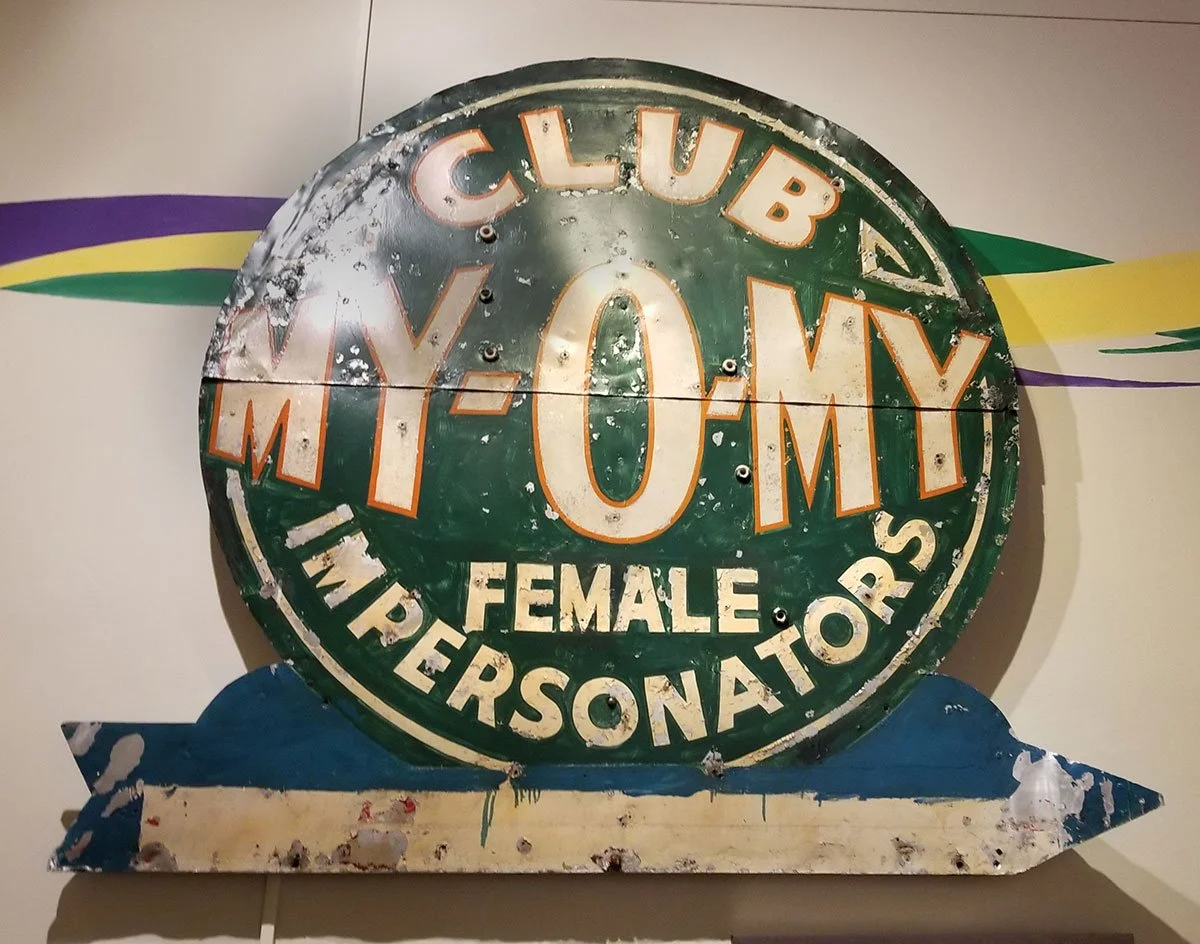My–Oh–My! A Look Back at Female Impersonator Venues in New Orleans
My Oh My postcard, courtesy Historic New Orleans Collection, gift of Jack Belsom, 2018.0540.4
August 2025The first club featuring female impersonators opened in New Orleans in 1933 at the edge of the French Quarter. Read on for a peek inside some of the most popular.
-by Frank Perez
If you were looking for female impersonators in New Orleans in 1944, all you had to do was look in the phone book. In that year, there were enough female impersonator clubs in the city to merit their own section in the Yellow Pages.
In 1933, Emma and Emile Morlet opened the Powder Puff club at 125 Decatur St. Partially inspired by European cabaret shows that showcased female impersonators, the Powder Puff was the first club in New Orleans to feature what we now know as drag shows.
The Powder Puff was a hit – in part because of its subversive nature. But the entertainment value itself was superlative. Performers then could actually pass for women, unlike their descendants today, whose costumes and personas are often exaggerated and obvious. Also, female impersonation night-clubs then featured live music: lip-syncing was unheard of.
The city declared the club a moral menace and passed an ordinance prohibiting cross-dressing except on Mardi Gras. After being raided by the police multiple times, the Morlets closed the Powder Puff and relocated to the West End in 1936.
Their new club was called the Wonder Club, and it became enormously popular. The club was located on Lake Pontchartrain and straddled the line between Orleans and Jefferson Parishes, a fact that solved the problem of police raids. The West End at that time was something of a vice district, housing casinos and nightclubs.
In 1946 or 1947, the Wonder Club became Club My-O-My and would go on to become one of the premiere female impersonation clubs in the nation. Greyline Tours would regularly bring busloads of tourists to the club. Shows featured six entertainers who performed to a live band. For a time, Al Hirt was a member of the house band.
The Gypsy Tea Room #2, The William Russell Jazz Collection at the Historic New Orleans Collection, acquisition made possible by the Clarisse Claiborne Grima Fund, MSS 520.120
Club My-O-My thrived on the lakefront until it was destroyed by fire in 1972. The club relocated back to the French Quarter but didn’t survive long. The times were changing and swanky nightclubs were slowly disappearing.
Female impersonation would survive in the strip clubs that were popping up all over upper Bourbon Street, but these acts were a far cry from anything seen at the My-O-My. Drag performers who were not strippers would eventually find homes in some of the gay bars that offered drag shows, one of the earliest of which was Travis’ at 834 N. Rampart Street.
Travis’ on North Rampart Street in the French Quarter, photo Vieux Carre Commission Virtual Library
The My-O-My is perhaps the most well-known of the early female impersonation clubs, but there were others. The Caldonia Inn, located in Treme (942 Henriette DeLille), opened in 1947. Today the club is chiefly remembered as launching the career of Professor Longhair, but what is less known is that the Caldonia also offered regular drag shows and welcomed gay patrons.
“As Trumpeter Frank Mitchell told author Jeff Hannusch, ‘The Caldonia had the best female impersonator show in the city. It was so popular that the white sissies started coming there until the police ran them off. We’d back their show and then play two sets of dance music’.” (this quote is from the website: https://acloserwalknola.com/places/caldonia-inn/)
The Caldonia Inn closed in 1971 when the city razed several blocks in Treme to make way for Armstrong Park. The club relocated for a time to 1533 St. Phillip Street.
Before it was the Caldonia Inn, the venue was the Gypsy Tea Room II. The Gypsy Tea Room also featured drag queens, including mid-century New Orleans’ most famous female impersonator, Patsy Vidalia.
Born Irving Ale in Vacherie, Louisiana, in 1921, Vidalia came to New Orleans in the mid-1940s. In addition to working briefly at the Gypsy Tea Room, Ale also performed at 'Club Desire' with a female impersonator group calling themselves the “Valdalia Sisters.”
Frank Painia, owner of the Dew Drop Inn, noticed Vidalia and offered her a job at his club. According to Bear-Family website, “There Patsy became a fixture for over a quarter of a century as the emcee, resident singer, waiter, bartender, and the host of the annual Halloween Gay Ball, featuring costume prizes for a host of estrogen-crazed, flaming female impersonators.”
Functioning as a barbershop, restaurant, hotel, lounge, and nightclub, the Dew Drop Inn—or the Groove Room as it was called—featured local talent as well as national stars such as Allen Toussaint, Tommy Ridgley, Earl King, Huey “Piano” Smith, Ray Charles, James Brown, Sam Cooke, Ike & Tina Turner, Otis Redding, Solomon Burke, and Little Richard.
Local legend says that Richard’s early hit, “Tutti Frutti,” – which was originally about anal sex – was born at the club when a resident musician there helped him rewrite the lyrics so it could be recorded. New Orleans record producer Bumps Blackwell had felt the original would be a hit but said the lyrics were too dirty.
Presiding over it all was resident host, Patsy Vidalia.
According to Quinn Bishop in a recent Gambit article, “Few could tell she was a female impersonator until she outed herself in the middle of the act. When she did, it was not uncommon for someone to heckle her. But her biting wit left them fleeing to the back of the bar with their tails tucked between their legs, with the audience cheering.”
Vidalia was unabashedly out, often telling audiences, “I know I’m cute and I know I’m sexually desirable as a woman, but don’t mess with me ‘Cause I'm a MAN!” (Bartlett 35). After desegregation, Vidalia also occasionally hosted at the My-O-My. She died in 1982.
Vidalia wasn’t the only female impersonator at the Dew Drop Inn. There was also Eskew Reeder. Reeder recorded his own songs, including the hit “Green Door,” and also recorded with other early musical pioneers such as Sam Cooke.
Described as very flamboyant, Reeder may have been the inspiration for Little Richard. Bartlett notes, “It was Eskew Reeder’s performance style that was largely responsible for the style of the somewhat younger Richard Penniman, better known as Little Richard.” (Bartlett 70). Little Richard performed in drag as Princess LaVonne.
The Dew Drop Inn as a live music venue closed in 1970 amid desegregation and Frank Painia’s failing health. After an extensive revitalization, it reopened in 2024.
Club My-O-My, the Caldonia Inn, and the Dew Drop Inn all closed in the early 1970s, but while they lasted, they provided a platform for early drag queens to perform and blaze a trail that persists today.
Historic New Orleans Collection, 2024.0288.1
Like queer culture in general, drag has become mainstream, primarily due to the debut of RuPaul’s television show Drag Race in 2009 and a general paradigm shift in public attitudes toward homosexuality since then.
Clorox Bleachman, photo courtesy Bleachman
But the time between the closure of the vintage female impersonation clubs of mid-century and the advent of RuPaul was a period of transition, some would say exploitation. During that time, straight clubs on Bourbon Street regularly advertised “Female Impersonators” as essentially strippers, while gay bars began to host what we now call drag shows.
Clorox Bleachman, originally from Kansas City, moved to New Orleans in 1976 and quickly befriended the late, great Donnie Jay, who Bleachman jokes, “was probably born in a dress.”
Jay performed at the My-O-My before it closed, and also had regular gigs at Travis’ and T.T.s. One evening in 1978, a drag queen backed out of her scheduled performance at T.T.’s.
Jay told Bleachman, “You have a theater background. You should fill in.” It was Bleachman’s first time in drag.
Noting the differences of the drag scene then and now, Bleachman observes, “Drag was more serious then, but we still made an effort to have fun with the audiences.”
This transitional period also saw the rise of the pageant circuit and, for a brief time, the Imperial court system.
Today, drag is ubiquitous in New Orleans: drag brunches, drag wrestling, drag storytelling, drag comedy, etc. But this diversity is a recent development. For decades, drag shows at gay bars fell into a routine that was predictable and stale—and not always welcoming to new ideas.
Vinsantos Defonte moved to New Orleans in 2010 from San Francisco and recalled in a 2019 interview, “It just seemed like there was a style and there wasn't much outside of that style … It was pageant queens and Top 40 queens, so a real traditional type of drag, and I didn't think that there was a place for me in that world. I couldn't get gigs. My character was too weird. I felt kind of shut out from the whole thing.” (Poche, Gambit)
Defonte wasn’t alone. He and others who shared the same frustration formed the New Orleans Drag Workshop in 2013, which trained emerging drag artists to be creative and innovative. Since its inception, the workshop has “draguated” over 100 performers.
In the collection of the Louisiana State Museum, courtesy Wayne Phillips
Citations
See https://www.queermusicheritage.com/fem-myomy.html for news clippings
Bartlett, Thomasine Marion. “Vintage Drag Female Impersonators Performing Resistance in Cold War New Orleans.” Ph.D. dissertation, Tulane University, 2004.
Poche, Kaylee. “As Drag Approaches the Mainstream, New Orleans' Queens Navigate Shifting Drag Culture.” Gambit. Aug. 19, 2019.
Bishop, Quinn. “The Forgotten History of How New Orleans’ Black Drag Queens Helped Shape Rock ‘n’ Roll.” Gambit. Jun. 26, 2025.








